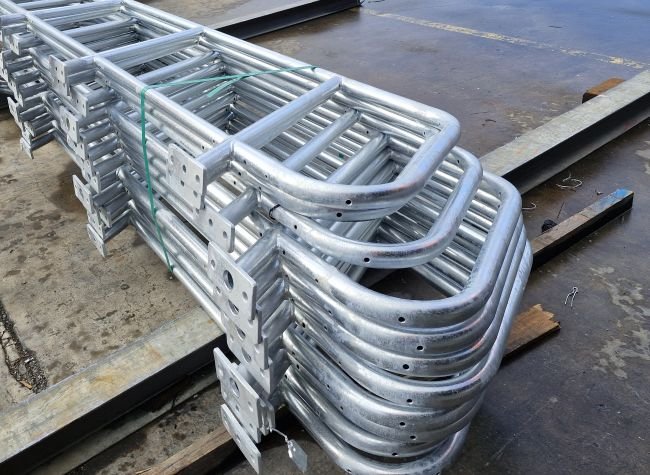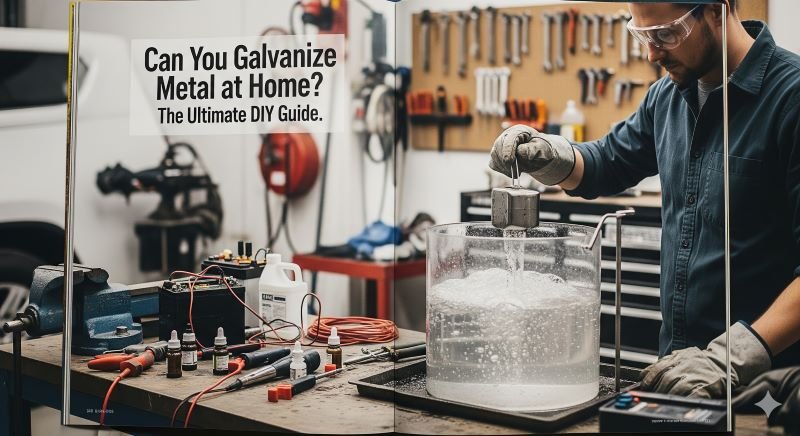Galvanizing is a lifesaving shield for steel and iron, protecting them from rust and corrosion with a zinc coating. But can you pull off this industrial magic trick in your backyard or garage? Let’s dive deep into the methods, risks, and DIY hacks—plus whether it’s worth the effort!
⚡ What Is Galvanizing? Breaking It Down
Galvanizing coats steel/iron with zinc, which sacrifices itself to protect the base metal from rust. Three main methods exist:

- Hot-Dip Galvanizing 🌡️: Dunking metal into molten zinc (over 800°F/427°C).
- Electrogalvanizing ⚡: Using electricity to bond zinc to metal.
- Cold Galvanizing 🎨: Painting on zinc-rich coatings.
Spoiler: Only one of these is truly DIY-friendly. Let’s explore why!
1. 🚫 Hot-Dip Galvanizing: Why It’s a Nightmare at Home

Process Overview
- Clean metal ➡️ Soak in acid (pickling) ➡️ Flux ➡️ Dip in molten zinc ➡️ Cool.
DIY Feasibility: Mission Impossible?
- Equipment Needed:
- A furnace that hits 800°F+ (like a custom forge or kiln).
- A zinc bath (melting 50+ lbs of zinc? 💰).
- Quenching tanks and ventilation systems.
- Cost: Zinc prices hover around 2.50–2.50–3.50 per pound—melting enough for a single project could cost $200+.
- Safety Risks:
- Zinc fumes cause “metal fume fever” (flu-like symptoms 🤒).
- Molten zinc splashes = severe burns.
- Fire hazards 🔥 from open flames or spilled metal.
Verdict: ❌ Not worth it. Leave this to factories with industrial gear!
2. ⚡ Electrogalvanizing at Home: A Risky Science Project
How It Works
- Submerge metal and zinc anode in electrolyte (e.g., zinc sulfate).
- Run electricity (1-6 volts) to transfer zinc ions to the metal.
DIY Setup
- What You’ll Need:
- DC power supply (old phone charger or car battery).
- Zinc anodes (buy online or salvage from zinc-coated items).
- Electrolyte solution (zinc sulfate or vinegar + salt).
- Acid bath (muriatic/hydrochloric acid for pickling).
- Step-by-Step:
- Clean metal with sandpaper or wire brush.
- Pickle in acid (wear gloves & goggles!).
- Submerge in electrolyte, connect wires, and wait.
Pros vs. Cons
- ✅ Cheaper than hot-dip (~$50 for small kits).
- ✅ Works for small items (nails, hooks, tools).
- ❌ Thin coating (5–25 microns vs. industrial 80–100 microns).
- ❌ Chemical hazards (acid burns, toxic fumes).
- ❌ Time-consuming (hours of prep and plating).
Safety Alert 🚨:
- NEVER mix acids casually—vinegar is safer, but hydrochloric acid requires a fume hood.
- Dispose of waste properly (EPA guidelines apply!).
Verdict: 🟡 Possible for hobbyists, but results are mediocre and risks are high.
3. 🎨 Cold Galvanizing: The Only Practical DIY Option
What Is It?
- Zinc-rich paint (92–95% zinc dust) sprayed or brushed onto metal.
Why It’s DIY Gold
- No special tools: Grab a $15 spray can (e.g., Rust-Oleum Cold Galvanizing Compound).
- Instant application: Dries in 15–30 minutes.
- Low risk: No flames, fumes, or acids!
But Wait…
- Durability: Lasts 2–5 years vs. 50+ years for hot-dip.
- Uses: Best for repairs, outdoor furniture, or farm equipment.
- Pro Tip: Scuff metal with sandpaper first for better adhesion!
Verdict: ✅ Perfect for small jobs—cheap, easy, and safe!
⚠️ Safety Checklist: Don’t Skip This!
- Hot-Dip: Industrial PPE only (fireproof suits, respirators).
- Electroplating:
- Ventilation: Use outdoors or in a well-ventilated area.
- PPE: Nitrile gloves, goggles, apron.
- Cold Galvanizing: Mask to avoid inhaling zinc dust.
🌍 Environmental & Legal Pitfalls
- Zinc waste is toxic to aquatic life 🐟. Never dump acids or zinc sludge down drains!
- Check local laws: Some regions restrict zinc oxide emissions or chemical disposal.
🔍 Final Verdict: Should You Try It?
| Method | Cost | Safety | Durability | DIY-Friendly? |
|---|---|---|---|---|
| Hot-Dip | $$$$ | 🔴 Hazardous | 50+ years | ❌ No |
| Electroplating | $$ | 🟡 Risky | 1–5 years | 🟡 Maybe |
| Cold Spray | $ | 🟢 Safe | 2–5 years | ✅ Yes |
Bottom Line:
- For most people: Use cold galvanizing spray 🎯. It’s cheap, instant, and harmless.
- For hardcore tinkerers: Try electroplating ⚡—but respect the chemistry!
- Hot-dip: Just… don’t. ❌
💡 Pro Tip: If your project needs long-term durability (e.g., fence posts, roofing), pay a pro. Industrial galvanizing costs 1–1–3 per pound and lasts decades!